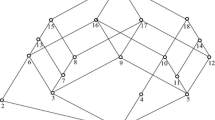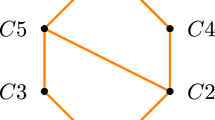Abstract
Granule description is a fundamental problem in granular computing. The existing studies are mainly based on Wille’s concept lattice, and attribute reduction techniques, e.g., minimal generators of granules, are often adopted to compute the most concise description of a given granule. However, on one hand, as the construction of concept lattice has a relatively high time complexity especially for large formal contexts, it may bring difficulties in real applications. On the other hand, how to use positive and negative attributes for granule description is still an open problem. In this paper, to improve the description efficiency, we first consider attribute-induced atomic granules as the building blocks of more complicated granules. And then, we discuss granule description based on positive and negative attributes, respectively. Finally, granule description is also investigated by combining positive and negative attributes. The main contribution of this study is to find the most concise descriptions of definable granules from the perspectives of positive and negative attributes.




Similar content being viewed by others
References
Ahmad SSS, Pedrycz W (2017) The development of granular rule-based systems: a study in structural model compression. Granul Comput 2:1–12
Bargiela A, Pedrycz W (2002) Granular computing: an introduction. Kluwer Academic Publishers, Boston
Bartl E, Konecny J (2016) \(L\)-concept analysis with positive and negative attributes. Inf Sci 360:96–111
Belardinelli A, Butz M (2014) Report on the 35th annual cognitive science conference. AI Mag 35(2):79–80
Bělohlávek R, De Baets B, Konecny J (2014) Granularity of attributes in formal concept analysis. Inf Sci 260:149–170
Bourne L (1970) Knowing and using concepts. Psychol Rev 77:546–556
D’Aniello G, Gaeta A, Loia V, Orciouli F (2017) A granular computing framework for approximate reasoning in situation awareness. Granu Comput 2:141–158
Davis R, Shrobe H, Szolovits P (2002) What is a knowledge representation? AI Mag 14(1):17–33
Düntsch I, Gediga G (2002) Modal-style operators in qualitative data analysis. In: Proceedings of the 2002 IEEE international conference on data mining. IEEE Computer Society, Washington, D.C., pp 155–162
Ganter B, Wille R (1999) Formal concept analysis: mathematical foundations. Springer, Berlin
Jia X, Shang L, Zhou B, Yao Y (2016) Generalized attribute reduction in rough set theory. Knowl Based Syst 91:204–218
Kent R (1996) Rough concept analysis: a synthesis of rough sets and formal concept analysis. Fundam Inform 27:169–181
Kuznetsov S, Obiedkov S (2002) Comparing performance of algorithms for generating concept lattices. J Exp Theor Artif Intell 14(2–3):189–216
Lang G, Li Q, Cai M, Yang T (2015) Characteristic matrixes-based knowledge reduction in dynamic covering decision information systems. Knowl Based Syst 85:1–26
Li J, Mei C, Lv Y (2013a) Incomplete decision contexts: approximate concept construction, rule acquisition and knowledge reduction. Int J Approx Reason 54(1):149–165
Li J, Mei C, Cherukuri A, Zhang X (2013b) On rule acquisition in decision formal contexts. Int J Mach Learn Cybern 4(6):721–731
Li J, Mei C, Xu W, Qian Y (2015) Concept learning via granular computing: a cognitive viewpoint. Inf Sci 298:447–467
Li J, Huang C, Qi J, Qian Y, Liu W (2017) Three-way cognitive concept learning via multi-granularity. Inf Sci 378:244–263
Medina J (2012) Relating attribute reduction in formal, object-oriented and property-oriented concept lattices. Comput Math Appl 64(6):1992–2002
Niu J, Huang C, Li J, Fan M (2018) Parallel computing techniques for concept-cognitive learning based on granular computing. Int J Mach Learn Cybern. https://doi.org/10.1007/s13042-018-0783-z
Novak V (2004) Intensional theory of granular computing. Soft Comput 8(4):281–290
Pawlak Z (1982) Rough sets. Int J Comput Inform Sci 11:341–356
Pawlak Z (1991) Rough sets-theoretical aspects of reasoning about data. Kluwer Publishers, Boston
Pedrycz W, Chen SM (2011) Granular computing and intelligent systems: design with information granules of high order and high type. Springer, Heidelberg
Pedrycz W, Chen SM (2015a) Granular computing and decision-making: interactive and iterative approaches. Springer, Heidelberg
Pedrycz W, Chen SM (2015b) Information granularity, big data, and computational intelligence. Springer, Heidelberg
Pedrycz W, Homenda W (2013) Building the fundamentals of granular computing: a principle of justifiable granularity. Appl Soft Comput 13:4209–4218
Qi J, Wei L, Yao Y (2014) Three-way formal concept analysis. Lect Notes Comput Sci 8818:732–741
Qi J, Qian T, Wei L (2016) The connections between three-way and classical concept lattices. Knowl Based Syst 91:143–151
Richard K (1972) Reducibility among combinatorial problems. In: Miller RE, Thatcher JW (eds) Complexity of computer computations. Plenum Press, New York, pp 85–103
Shivhare R, Aswani Kumar Ch (2017) Three-way conceptual approach for cognitive memory functionalities. Int J Mach Learn Cybern 8(1):21–34
Singh PK (2017b) Three-way fuzzy concept lattice representation using neutrosophic set. Int J Mach Learn Cybern 8(1):69–79
Singh PK (2018a) Bipolar fuzzy concept learning using next neighbor and Euclidean distance. Soft Comput. https://doi.org/10.1007/s00500-018-3114-0
Singh PK (2018b) Similar vague concepts selection using their Euclidean distance at different granulation. Cogn Comput 10(2):228–241
Singh PK (2018c) Interval-valued neutrosophic graph representation of concept lattice and its (\(\alpha, \beta, \gamma\))-decomposition. Arab J Sci Eng 67:52–62
Singh PK (2018d) m-polar fuzzy graph representation of concept lattice. Eng Appl Artif Intell 43(2):723–740
Singh PK, Aswani Kumar Ch (2014) Bipolar fuzzy graph representation of concept lattice. Inf Sci 288:437–448
Singh PK, Aswani Kumar Ch (2017) Concept lattice reduction using different subset of attributes as information granules. Granul Comput 2(3):159–173
Wang G (2017) DGCC: data-driven granular cognitive computin. Granul Comput 2(4):343–355
Wang L, Liu X (2008) Concept analysis via rough set and AFS algebra. Inf Sci 178(21):4125–4137
Wang Y, Wang Y (2006) Cognitive informatics models of the brain. IEEE Trans Syst Man Cybern Part C Appl Rev 36(2):203–207
Wang G, Yang J, Xu J (2017) Granular computing: from granularity optimization to multi-granularity joint problem solving. Granul Comput 2(3):105–120
Wei L, Wan Q (2017) Granular transformation and irreducible element judgment theory based on pictorial diagrams. IEEE Transactions on Cybernetics 46(2):380–387
Wille R (1982) Restructuring lattice theory: an approach based on hierarchies of concepts. In: Rival I (ed) Ordered sets. Reidel, Dordrecht, pp 445–470
William-West TO, Singh D (2018) Information granulation for rough fuzzy hypergraphs. Granul Comput 3(1):75–92
Wu X, Zhang C, Zhang S (2004) Efficient mining of both positive and negative association rules. ACM Trans Inf Syst 22(3):381–405
Wu W, Leung Y, Mi J (2009) Granular computing and knowledge reduction in formal contexts. IEEE Trans Knowl Data Eng 21(10):1461–1474
Xu W, Li W (2016) Granular computing approach to two-way learning based on formal concept analysis in fuzzy datasets. IEEE Trans Cybern 46(2):366–379
Xu W, Pang J, Luo S (2014) A novel cognitive system model and approach to transformation of information granules. Int J Approx Reason 55(3):853–866
Xu W, Li W, Zhang X (2017) Generalized multigranulation rough sets and optimal granularity selections. Granul Comput 2(4):271–288
Yao Y (2001) Modeling data mining with granular computing. In: Proceedings of the 25th annual international computer software and applications conference. IEEE Computer Society, Washington, D.C., pp 638–643
Yao Y (2004) Concept lattices in rough set theory. In: Proceedings of 23rd international meeting of the North American Fuzzy Information Processing Society. IEEE Computer Society, Washington, D.C., pp 796–801
Yao Y (2009) Interpreting concept learning in cognitive informatics and granular computing. IEEE Trans Syst Man Cybern Part B Cybern 39(4):855–866
Yao Y (2010) Three-way decisions with probabilistic rough sets. Inf Sci 180:341–353
Yao Y (2016a) Rough-set analysis: interpreting RS-definable concepts based on ideas from formal concept analysis. Inf Sci 346–347:442–462
Yao Y (2016b) A triarchic theory of granular computing. Granul Comput 1(2):145–157
Yao Y (2016c) Two sides of the theory of rough sets. Knowl Based Syst 80:67–77
Yao Y (2017) Interval sets and three-way concept analysis in incomplete contexts. Int J Mach Learn Cybern 8(1):3–20
Yao Y, Zhou B (2007) A logic language of granular computing. In: Proceedings of the 6th IEEE international conference on cognitive informatics. IEEE Computer Society, Washington, D.C. pp 178–185
Yu H, Li Q, Cai M (2018) Characteristics of three-way concept lattices and three-way rough concept lattices. Knowl Based Syst 146:181–189
Zadeh L (1997) Towards a theory of fuzzy information granulation and its centrality in human reasoning and fuzzy logic. Fuzzy Sets Syst 19:111–127
Zhang W, Qiu G (2005) Uncertain decision making based on rough sets. Tsinghua University Press, Beijing
Zhi H, Li J (2016) Granule description based on formal concept analysis. Knowl Based Syst 104:62–73
Zhi H, Li J (2018) Influence of dynamical changes on concept lattice and implication rules. J Mach Learn Cybern 9:705–805
Acknowledgements
This work was supported by the National Natural Science Foundation of China (nos. 61502150 and 61562050).
Author information
Authors and Affiliations
Corresponding author
Rights and permissions
About this article
Cite this article
Zhi, H., Li, J. Granule description based on positive and negative attributes. Granul. Comput. 4, 337–350 (2019). https://doi.org/10.1007/s41066-018-0113-6
Received:
Accepted:
Published:
Issue Date:
DOI: https://doi.org/10.1007/s41066-018-0113-6




